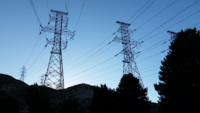
Photo from wikipedia
The increase in the price of fossil fuel due to its rarity and emissions means more integration of renewable energy sources (RESs) is required to improve economic management of the… Click to show full abstract
The increase in the price of fossil fuel due to its rarity and emissions means more integration of renewable energy sources (RESs) is required to improve economic management of the grid. This study analyses a combination of the tie-line power between conventional power sources and the renewable energy system and its frequency deviations which are known as area control error. The minimisation of the tie-line by optimal control is affected in such a way that the frequency and tie-line power error can be minimised while maintaining the power balance between generation and load. The tie-line connected to the microgrid consists of two main parts, namely the conventional source and the renewable energy source, each made up of a synchronous generator. The control application of the active power and frequency to a network is referred to as load frequency control (LFC) with the storage system as an integral part of RES. The simulation results show the performance of the proposed optimal control model in microgrid during the changing loads' condition, where the energy storage system applied to optimal control has shown a quick response to frequency deviation, which is close to 80%.
Journal Title: IET Renewable Power Generation
Year Published: 2019
Link to full text (if available)
Share on Social Media: Sign Up to like & get
recommendations!